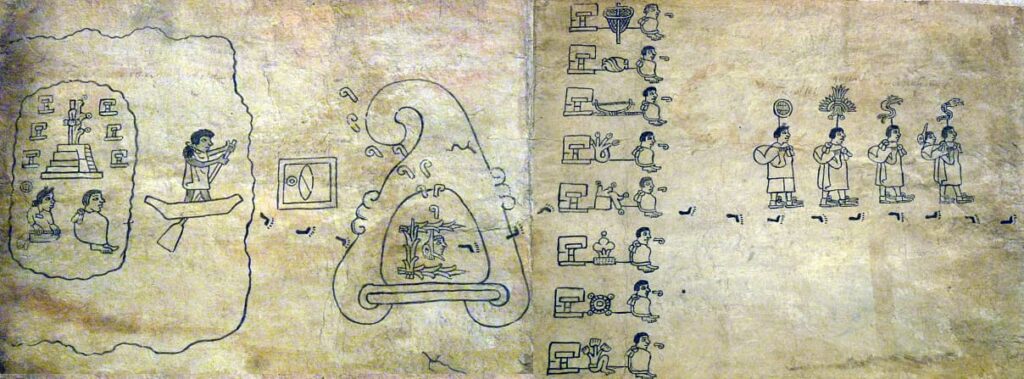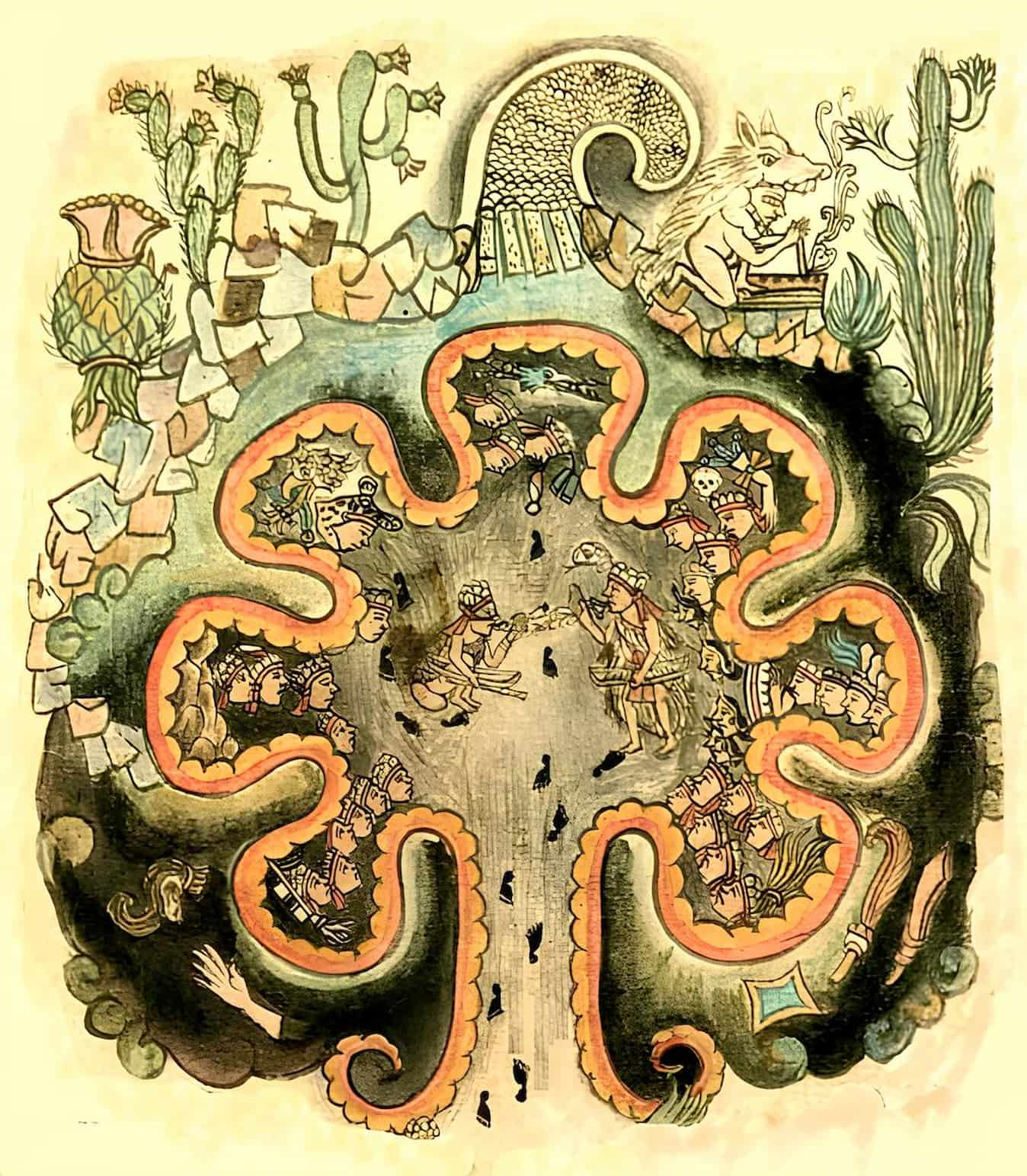Chicomoztoc (from Nahuatl, meaning ‘Place of Seven Caves,’ where ‘chicomo’ is seven, ‘ostotl’ is cave, and ‘-c’ is locative) is the name of the mythical place of origin for the Tepanec, Xochimilca, Chalca, Acolhua, Tlahuica, Tlaxcalteca, and Mexica peoples, collectively known as the “Seven Nahua Tribes.” This region was located in central Mexico in Mesoamerica during the postclassic period.
There is an association of Chicomoztoc with certain traditions related to the legendary Colhuacán (“place of people with ancestors”), perceived as a prestigious and revered place by the Nahua tribes. In written Nahuatl codices, the glyph representing the toponym of Colhuacán took the form of a “twisted” or “curved” hill. Some researchers have attempted to identify Chicomoztoc.
Legends
According to Aztec myths, in ancient times, they, along with other peoples, lived not in the Mexican Valley but in a common ancestral land located somewhere to the north, known as Chicomoztoc. According to one version of the Chicomoztoc myth, it was inhabited by a figure named Ilankueitl, who had seven sons from his two wives (association with the “seven caves”). These sons became the ancestors of the major ancient Mexican peoples: Otomitl gave rise to the Otomi, Miskotl to the Mixtecs, Ulmekatl to the Olmecs, and Tenuch (Tenoch) to the Tenochcas, i.e., the Aztecs.
However, there are mythical versions of Chicomoztoc suggesting that it was the ancestral land not of all Mexican peoples but only of one linguistic group, the Nahua. In this version, the myth of Chicomoztoc intersects with myths about Aztlan, the ancestral land of the Aztecs. According to some Aztec myths, they migrated from Aztlan through Chicomoztoc to Anahuac (the Mexican Valley), while others suggest the opposite route—from Chicomoztoc through Aztlan to Anahuac.
Theories of Existence and Location
The legend of Chicomoztoc possibly emerged with the creation of the empire led by Itzcoatl. During this period, the Chichimec Tlacaelel ordered the destruction of old books and the writing of new ones. In this period, the legend of Chicomoztoc merged with the legend of Aztlan or incorporated a new aspect—Aztlan. The Aztecs might have adopted the myth of Chicomoztoc from the Chichimecs, a tribe that was powerful in Anahuac for a long time, or from the Tepanecs, who were hegemonic in the valley after the Chichimecs.
In Aztec codex drawings, Chicomoztoc is depicted as a stylized cave with seven branches (Fig. 1). In this representation, it likely reflects widespread associations in the mythologies of ancient Mexican peoples between the cave and the womb of the revered mother-earth: according to some versions of Mesoamerican myths, the first people were born from a cave, and it became their first dwelling. Sometimes Chicomoztoc was portrayed not as a paradise cradle of humankind but as a horrifying area filled with wild beasts.
According to some indigenous chronicles, the migration from Chicomoztoc began in 820 AD and lasted for more than 80 years. Stops along the way led to conflicts between the Aztecs and other Nahua tribes (political, economic, or religious disputes—deciding which deity to worship). This continued until other Nahua tribes reached the Mexican Valley independently and earlier than the Aztecs. Eventually, in the 12th century, the Aztecs completed their journey from Chicomoztoc to Anahuac.
According to another version, Chicomoztoc served as a common resettlement place for many peoples who later settled in the Mexican Valley. This implies access to drinking water and opportunities for hunting or gathering. Some researchers suggest that it could be the present-day city of San Isidro Culhuacan.
History

Depending on the source consulted, the role of Chicomoztoc varies from being the initial pilgrimage site for the seven Nahua tribes to being a stopping point for some of the migrations originating from Aztlan. According to the Codex Boturini, after leaving Aztlan, the pilgrimage reached Chicomoztoc, where they settled for some time.
From this place, codices enumerate seven sequential migrations of the following peoples: Xochimilca, Chalca, Tepaneca, Acolhua, Tlahuica, Tlaxcalteca, and Mexica. It is noteworthy that various codices mention many other migrations originating from Chicomoztoc (although without specifying if these peoples also originated from Aztlan), such as Cuitlahuica, Mizquica, Amecameca, Huexotzinca, Matlazinca, Malinalca, and Cohuixca, which settled throughout Anahuac.
Aztlan-Chicomoztoc Controversy
There is controversy regarding the relationship between these two places. One of the main disputes is that Tezozomoc does not distinguish between Aztlan, Chicomoztoc, and Colhuacan. Additionally, Friar Diego Durán, a Spanish historian of the Dominican Order, asserts that both Aztlan and Chicomoztoc refer to the same place. Friar Bernardino de Sahagún, a historian from the Spanish colonial era, does not mention Aztlan, and Lorenzo Boturini Benaducci states that Aztlan is the origin of the pilgrimage, and Chicomoztoc is just a step in the pilgrimage.
Migrations
The dates of the migrations are currently unknown. Depending on the source, there are various mentions of when they arrived in Anahuac. The following table reflects the first and last mention, along with detailing the most accepted arrival date:
| Village | First mention | Last mention | Proposed year |
|---|---|---|---|
| Xochimilca | 1180 | 1240 | 1200 |
| Chalca | 1200 | 1200 | 1200 |
| Tepanec | 1150 | 1240 | 1200 |
| Acolhua | 1150 | 1270 | 1200 |
| Tlaxcala | 1210 | 1280 | 1220 |
| Mexica | 1240 | 1260 | 1250 |
Proposed Location
The proposed real location of Chicomoztoc is diverse. Currently, Cerro Culiacán, located in the Mexican state of Guanajuato, has been identified by various historians as Chicomoztoc, mentioned in ancient chronicles. This volcano is situated in the vicinity of three municipalities: Cortázar, Salvatierra, and Jaral del Progreso.
As its ancient name suggests, Chicomoztoc, “place of seven caves,” features seven main caves among the more than 200 caves on the hill, including niches, rocky shelters, and caves of considerable depth. These are defined as the seven most important and large caves on the hill, all of which show evidence that humans used and knew them.


